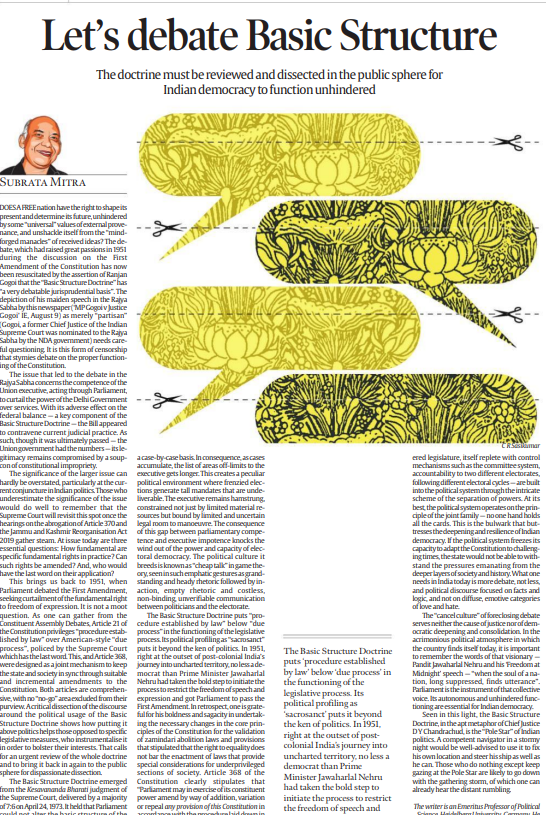THE BASIC STRUCTURE DOCTRINE AND ITS IMPLICATIONS FOR INDIAN DEMOCRACY
GS 2: Basic Structure
Introduction:
- The ongoing discourse in India revolves around whether a sovereign nation has the autonomy to shape its trajectory without being constrained by external “universal” values.
- This debate, rekindled by Ranjan Gogoi’s assertion that the “Basic Structure Doctrine” lacks a strong jurisprudential foundation, is reminiscent of the 1951 deliberations on the First Amendment.
- These discussions touch upon India’s political and constitutional landscape.
Resuscitation of the Debate:
- Ranjan Gogoi’s assertion regarding the “Basic Structure Doctrine” has reignited the conversation about whether this doctrine is grounded in legal principles.
- Critics label Gogoi’s statement as “partisan,” yet stifling such discourse obstructs conversations about the Constitution’s functionality.
Issue: Competence of Union Executive:
- At the heart of this debate lies the competence of the Union executive to limit the powers of the Delhi Government over services.
- This raises concerns about the federal balance, a key facet of the Basic Structure Doctrine.
- The contentious bill’s passage, despite constitutional misgivings, highlights the compromised legitimacy due to potential constitutional impropriety.
Broader Significance and Relevance:
- This holds significance in India’s current political landscape and anticipates the Basic Structure Doctrine’s prominence in discussions on Article 370’s abrogation and the Jammu and Kashmir Reorganisation Act 2019.
- The core questions arising from this are the practical significance of specific fundamental rights, their modifiability, and the ultimate authority for their enforcement.
Historical Context: First Amendment and Constitutional Principles:
- Drawing parallels with 1951, the dialogue recalls the debate over the First Amendment aiming to restrict the freedom of expression.
- Article 21 of the Constitution, favoring “procedure established by law” over “due process,” aimed to synchronize state and society through incremental constitutional amendments.
- This contends that leveraging the Basic Structure Doctrine for political gain impedes certain legislative measures.
Evolution and Consequences of the Doctrine:
- The roots of the Basic Structure Doctrine trace back to the 1973 Kesavananda Bharati judgment, which established that Parliament couldn’t amend the Constitution’s fundamental structure.
- Yet, the specific definition of these core features remains adaptable and subject to case-specific interpretation, consequently curbing executive powers.
- This paradox limits the feasibility of grand electoral mandates by circumscribing executive authority and nurturing a culture of “cheap talk.”
Impact on Legislative Dynamics:
- The dialogue critiques how the Basic Structure Doctrine places “procedure established by law” beneath “due process,” influencing the legislative course.
- By sanctifying it, the doctrine withdraws from political realms.
- The article highlights Jawaharlal Nehru’s move to restrain freedom of expression via the First Amendment as a bold response to evolving constitutional requirements.
Balancing Power in Indian Democracy:
- This accentuates the equilibrium between an alert judiciary and an empowered legislature in Indian politics, both grounded in the principle of separation of powers.
- These mechanisms cultivate resilience and adaptability within democracy.
- Hindering this adaptability, the article cautions, could undermine the state’s capacity to manage societal pressures.
Necessity of Debate and Democratic Discourse:
- The narrative calls for a more open debate and rational political discourse in India.
- Suppressing differing views, it argues, undermines justice and democratic stability.
- Quoting Jawaharlal Nehru, it asserts that a nation’s stifled essence seeks expression through its parliamentary voice.
- The autonomous functioning of Parliament remains pivotal for Indian democracy.
Conclusion:
The discourse concludes by likening the Basic Structure Doctrine to a “Pole Star” of Indian politics.
It advises leveraging this doctrine’s guidance without fixating on it, similar to a skilled navigator using the Pole Star amidst tumultuous waters.
Failing to do so could lead to a metaphorical storm’s turmoil, underscoring the importance of a balanced political engagement and unfettered dialogue.
Discuss the resurgence of the debate surrounding the ‘Basic Structure Doctrine’ in the context of Indian democracy. Analyze its implications on the balance of power between the executive and the judiciary, its historical foundations, and the broader significance it holds for constitutional interpretation and democratic discourse in India.
ENVIRONMENTAL IMPACT OF INFRASTRUCTURE PROJECTS IN THE HIMALAYAS
GS 3: Disaster Management
The Contrasting Image of the Himalayas
- The Himalayas have been celebrated for their breathtaking beauty and spiritual significance.
- However, beneath the poetic awe that the snow-capped peaks inspire, lies a grim reality.
- The landscape has been subject to steady environmental degradation, evidenced by the increasing natural disasters like landslides and floods in the hill states of Uttarakhand and Himachal Pradesh.
- The events serve as cautionary tales of flawed development practices in this eco-sensitive region.
Bypassing Environmental Regulations
- The Chardham Mahamarg Vikas Pariyojna, initiated in 2016, is a glaring example of such practices.
- The project involves 900 km of road widening in the Garhwal and Kumaon regions of Uttarakhand.
- The undertaking has had severe environmental consequences, including deforestation and soil erosion.
- Moreover, the project cleverly bypassed Environmental Impact Assessment (EIA) requirements by splitting itself into 53 smaller projects, each less than 100 km long.
- This manipulation of regulations has allowed unchecked damage to the environment.
The Vulnerability of Bhagirathi Eco Sensitive Zone (BESZ)
- BESZ stands as the last untouched stretch of the Ganga River, protected under the Environment Protection Act, 1986.
- However, even this zone is now threatened due to hurried approvals for the Chardham project, bypassing Supreme Court directions and mandatory EIAs.
- The result is a looming danger to thousands of deodar trees and pristine mountain slopes.
Unanswered Questions and Legal Violations
- The Ministry of Road Transport contradicted its own guidelines regarding road dimensions in hill terrains.
- These contradictions were highlighted in a Supreme Court appeal in 2020, yet little has been done to address them.
- The government justified the inconsistency in road-width requirements by citing “national security,” but the rationale remains questionable on multiple fronts.
Overburdening Carrying Capacities
- Tourism-driven economic pressures have led to an increase in the carrying capacity of several shrines in Uttarakhand, even though experts have cautioned against it.
- The rush to boost the tourism sector seems to have neglected environmental sustainability, as well as the well-being of local communities.
Climate Change and the Need for Regulation
- One of the pressing issues is the accelerated melting of the Gangotri glacier due to increased black carbon deposits.
- Such signs indicate that the debate between environmental conservation and development should tilt toward stricter regulations.
- Experts argue that a one-size-fits-all approach to environmental clearance is dangerous, especially for sensitive areas like the Himalayas.
Conclusion
- The Himalayas are at a critical juncture where the choice between short-term economic gains and long-term environmental sustainability will have irreversible consequences.
- Adopting a regulatory approach that prioritizes environmental conservation is not just ethically right but also essential for the long-term well-being of the region and its people.
- If a slight reduction in road width ensures the preservation of the last pristine stretch of the Ganga and the Himalayas, then it is a small price to pay for sustainable development.
Questions: Evaluate the efficacy of existing environmental regulations, particularly in the context of the Bhagirathi Eco Sensitive Zone (BESZ). How can legal provisions be strengthened to prevent bypassing of important environmental assessments?
ADDRESSING THE ERA OF GLOBAL BOILING THROUGH SOIL MANAGEMENT AND SUSTAINABLE PRACTICES
Introduction and Context
- The United Nations Secretary General has declared that we have entered the era of global boiling, essentially highlighting the urgency to combat climate change.
- Following systems thinking, this article identifies leverage points for impactful change.
- The core issue boils down to carbon emissions and how they are disrupting the natural balance of the earth’s atmosphere.
The Carbon Cycle and Human Activity
- The planet once maintained a natural balance of carbon through photosynthesis by plants and microbiological life.
- Human activities like agriculture and the burning of fossil fuels have led to increased carbon emissions.
- This has triggered a vicious cycle affecting global ice caps, permafrost, and sea levels.
- The consequences stretch from environmental degradation to threats on food and water supply, subsequently leading to human conflict and warfare.
The Importance of Soil
- This identifies soil as a significant leverage point.
- Soil is not just the foundation for agriculture but also a critical component in the carbon capture process.
- Poor soil management has already led to degradation in more than one-third of the world’s soil, threatening future food security.
Faults in Modern Agriculture and Food Production
- Modern industrialized agriculture has caused a range of issues from unhealthy eating habits to significant food wastage.
- Mono-culture crops and use of chemicals are not only harmful to biodiversity but also disregard the importance of carbon capture.
- Large corporations primarily dominate food production, often at the expense of small farmers and sustainable practices.
Solution: A Farmer-Centric Approach
- A promising approach involves focusing on regenerative farming practices like permaculture and re-forestation, which could also give rise to new income sources such as carbon credits.
- While the global carbon market is currently flawed, initiatives like these can still have localized benefits.
International Awareness and Policy Agenda
- Recent disruptions in grain and fertilizer supply chains, due to events like the war in Ukraine and India’s export limitations on rice, have brought food self-sufficiency to the forefront of policy agendas.
Alternative Techniques and Funding
- Technologies like the Johnson-Su bioreactor method and ancient techniques like terra preta are highlighted as viable means to improve soil quality.
- Social impact projects aimed at regenerating soil, forests, and water sources are touted as being as important as traditional infrastructure projects, deserving of support from social stock exchanges and philanthropic organizations.
Conclusion: Local Adaptation for Global Change
- This posits that regenerating the soil is a pragmatic, not utopian, path to tackling climate change and its cascading impacts on society.
Those who think in systems but act locally will be the ones most likely to navigate the challenges ahead, while those who deny the need for change are least likely to survive the upcoming crises.




